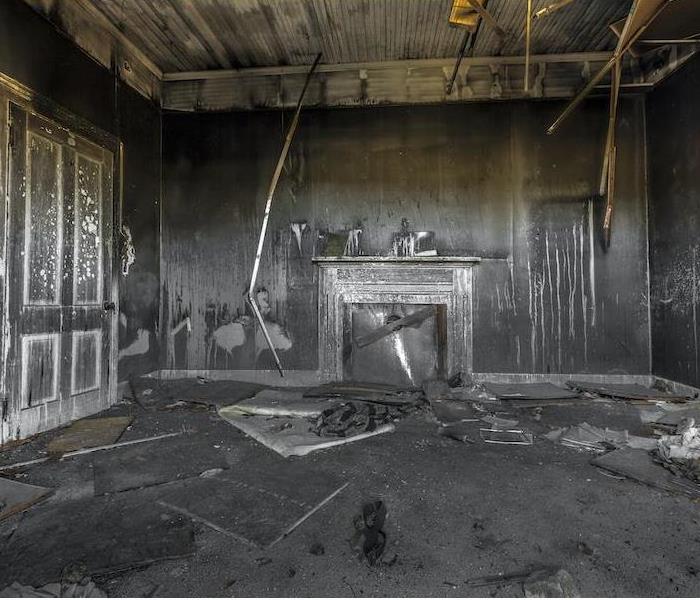How Does Soot Get Removed from Fire-Damaged Newport Homes?
9/3/2020 (Permalink)
 You can count on our professionals with state of the art equipment to quickly restore your property so you can return safely after a fire incident.
You can count on our professionals with state of the art equipment to quickly restore your property so you can return safely after a fire incident.
Soot is one of the most destructive effects of a fire loss, making it a priority to remove when restoration and mitigation get underway.
Fire losses that threaten Newport homes and businesses can damage the property in many ways. Among the most challenging to overcome is the presence of smoke residues and soot. Puff backs are a typical example of this threatening black residue throughout the house when an oil furnace has a small explosion in the ignition chamber. Soot can also occur through partial combustion of exposed materials and contents in your home. A thick residue can be a substantial burden for cleaning technicians and present hazardous conditions for the property, so our SERVPRO team works to remove this carcinogen wherever it gets found.
There are many layers and levels of fire damage in Newport homes that responding technicians like ours must address and overcome. While much of these concerns can get resolved during the mitigation phases with the application of advanced tools and technologies, soot can be a threat in multiple ways. From circulating particles to thick surface residues, there are varying strategies to resolve each of these types of soot and soiling damages to the structure and its contents.
How Does Airborne Soot Get Removed?
Circulating soot particles are microscopic, meaning that you might not always be able to identify their presence with the naked eye. Their small size is also hazardous in that breathing in these particulates can allow them to sit deeply into the lungs of those exposed, leading to respiratory conditions or worse. Removing these particles often requires several strategies that begin with addressing the present free-floating carcinogens and the residues on surfaces and contents throughout the structure. A combination of filtering and air purification tools can screen out particles as small as .03 microns with HEPA filtration screens. Tools and tactics for clearing the air often include:
- Air Scrubber
- Hydroxyl Generators
- Air Duct Cleaning
What Steps Are Necessary for Soot Removal on Surfaces?
Soot and smoke residues often vary based on the material affected and the combusting materials. Protein residues, for example, get produced from grease fires in the kitchen. The incomplete combustion of fuels like wood produces thick smoke soiling that coats wall surfaces, ceilings, and floors throughout your house. There are multiple solutions to address these acidic residues, and they get selected based on the underlying materials impacted. We can pre-test potential cleaning strategies through small sample spaces to determine the most efficient approach for your specific construction materials, paints, wallpaper, and other involved products. These strategies for residue removal often include:
- Soda Blasting – With pressurized air or even water combined with media like baking soda, this cleaning approach can dislodge and blow away thick soot residues on surfaces without damaging the underlying substrate.
- Agitative Cleaning – Brushing, vacuuming, and feather dusting can be useful in removing dry smoke residues and a preliminary action to take with thicker soot residues before emulsification.
- Chemical Solvents – Oil-based soils can benefit from the application of oil-based solvents. Testing the effectiveness of specific cleaning products can identify the type of residue and the best approaches for removing it.
- Controlled Demolition – When all else fails, removing the impacted material entirely and later replacing it is the most direct restoration path.
How Do Damaged Contents Get Cleaned?
Your personal belongings can often also get highly damaged by circulating soot particles and residues forming on the surfaces of exposed items. Relocating these belongings to our nearby facility can allow for intricate cleaning and restoration actions to take place, such as:
- Ultrasonic Tank – Hard materials like glass and ceramics coated with soot residues can benefit from time in the immersion tank. Millions of exploding microscopic bubbles loosen soils on the damaged item and thoroughly clean every crevice.
- Surface Cleaning with Solvents – Surface cleaning is necessary for many of the items brought into our SERVPRO warehouse after a fire. We can identify the type of soiling and use chemical solvents, agitative practices, and abrasive methods to remove surface soot.
- ESPORTA Wash System – Clothing and soft materials that cannot stand up to the immersion tank can get thoroughly cleaned with a gentle cycle with this advanced restoration technology.
Soot is often one of the most challenging obstacles for our team and homeowners to overcome after a fire loss incident. With so many variations of how this can damage your property, our experienced SERVPRO of Hockessin / Elsmere team can help with multiple approaches tailored to any soot presence in your house. Give our emergency line a call anytime at (302) 992-0104.






 24/7 Emergency Service
24/7 Emergency Service